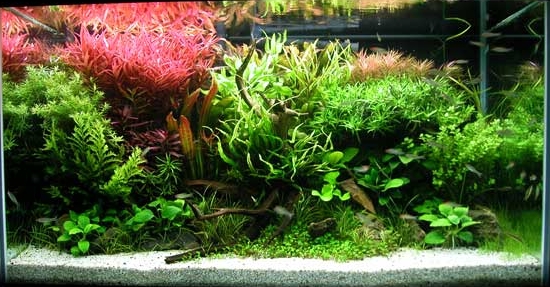 Here are some tips for getting the best growth and appearance from your live freshwater aquarium plants:
Here are some tips for getting the best growth and appearance from your live freshwater aquarium plants:
• Don’t use gravel which is too coarse. We can help in pointing out the best choices for optimum plant growth. Depth of gravel should be a minimum of three and preferably four inches. Gravel color is irrelevant. The use of fluorite under the gravel is highly recommended.
• Maintain adequate lighting. Research indicates that the intensity of light is even more important than the duration. A typical color-enhancing bulb, such as a gro-lux, may be adequate for a ten gallon (or other 12- inch tall tank) but taller tanks need a higher degree of luminance. We strongly suggest two entirely different types of bulb be used. One choice would be a color-enhancing bulb in front to show your fish to their best advantage, and a bulb more advantageous to plant growth in the rear.
• Remember to use fertilizer. The old adage that fish droppings will fertilize the plants in an aquarium is partially true. Modern filtering techniques now often render the aquarium too sterile! Most liquid fertilizers, in addition to replacing needed trace elements and minerals, actually aid in changing mulm (a pretty word for fish droppings) into substances which are more easily absorbed by the plants’ roots. A good quality liquid fertilizer may be adequate for a beginner’s aquarium or even one of small dimensions. However, those wanting optimum results, especially for swordplants, anubias varieties, cryptocorynes, and any plants that send runners to reproduce, would be wise to purchase one of the many products available that apply fertilizer directly to the gravel.
• Prune your plants periodically. It is generally advisable to place some plants toward the rear of the tank in order to hide heaters, siphons and the like. Next, rocks or driftwood will hide the less-attractive lower plant sections as well as offer contrast and a sense of depth. Midrange plants are then placed with another level of rocks or other decorations. Lastly, small foreground plants in the very front complete the descending motif and further hide the bottoms of plants immediately to their rear. Most of this is common sense, but this initial plan can easily go astray if some pruning isn’t done as the plants mature.
• Avoid an undergravel filter if at all possible. There are instances where we’ve heard of successful plant growth when using an undergravel filter, particularly one with slow water turnover. But in general, it’s a bad idea. If you must have one, or already have one and don’t want to remove it, consider leaning heavily on potted or plastic plants.
• Be careful of medications. Some medications that are not directly harmful to fish can be lethal to living plants. Dyes such as malachite green and methelene blue should not be used. In addition, many antibiotics can be equally dangerous to plants. There are medications available which are less harmful. Carefully reading labels is always a necessity before introducing any foreign substance that can affect the balance of the aquarium’s system and should be followed with plants in mind as well as fish!
